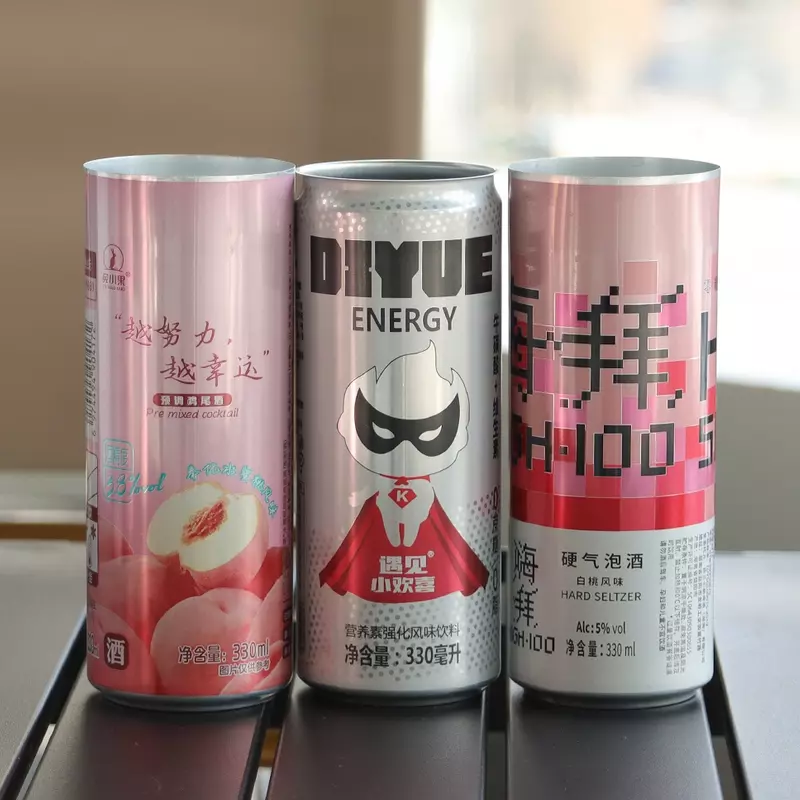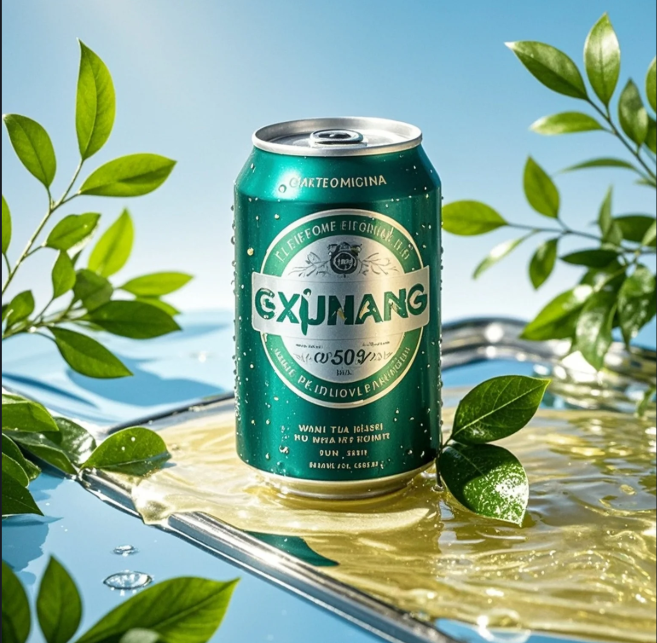
Aluminum cans are everywhere — from your favorite soda to energy drinks and canned cold brews. But did you know that each of these aluminum beverage cans hides something invisible inside? It’s not just metal holding your drink. There’s a thin layer of plastic — and it plays a much bigger role than most people realize.
This article explores why aluminum cans are lined with plastic, what materials are used, whether it’s safe, and what this means for recycling and your health.
What Is the Coating Inside an Aluminum Can?
While aluminum looks clean and metallic on the outside, inside most cans is a clear or slightly tinted epoxy coating. This ultra-thin film — just 1 to 10 microns thick — is sprayed inside the can to form a protective barrier between the metal and the beverage.
In the can industry, this is called a “lacquer”, and it's usually made from plastic-based materials like epoxy resin, vinyl, or acrylic. Despite being invisible and often ignored, this coating is one of the most engineered parts of a standard can.
![aluminum beverage cans aluminum beverage cans]()
Why Do Aluminum Cans Need a Plastic Coating?
At first glance, aluminum might seem like a sturdy, non-reactive metal — perfect for packaging food and beverages. But in reality, aluminum is chemically quite active, especially when it comes into contact with certain acids, salts, and preservatives commonly found in modern drinks and processed foods.
Sodas, energy drinks, fruit juices, sports drinks, and even some flavored waters often contain citric acid, phosphoric acid, or high chloride levels — all of which can trigger corrosion in bare aluminum. If there were no protective barrier inside the can, these beverages would begin breaking down the metal surface within days. The result? Metallic flavors, gas loss, weakened structural integrity, leaks, and in extreme cases, even micro-perforations that lead to product failure and spoilage.
To prevent all of this, manufacturers apply a thin layer of plastic coating, also known as lacquer, on the interior walls of aluminum cans. This layer plays multiple crucial roles — not just one. Let’s break them down:
Function | Purpose |
Corrosion Resistance | Prevents acids and salts from reacting with and degrading the aluminum |
Flavor Preservation | Stops metallic leaching that can alter the taste and aroma of the beverage |
Carbonation Protection | Maintains the pressure and fizz by sealing micro-gaps in the metal surface |
Product Safety & Shelf Life | Avoids leaks, bacterial contamination, and extends storage viability |
Packaging Durability | Enables cans to withstand stacking, shipping, and environmental changes |
Real-World Examples of Corrosion Risks
Even seemingly mild beverages like Diet Coke can be surprisingly corrosive due to their artificial sweeteners and acidic content. Without a protective liner, a can of diet soda would likely corrode from the inside out in under a week. Fruit juices, particularly those from citrus fruits, are also highly acidic and would not last long in a bare aluminum can.
Some energy drinks are so chemically aggressive that no existing coating can fully protect the can from long-term exposure. For this reason, certain formulations are either reformulated or packaged in alternative containers, such as glass bottles or multilayer cartons.
Why Not Use Thicker Aluminum Instead?
One might wonder: why not just use thicker aluminum to withstand corrosion? The answer lies in cost, weight, sustainability, and manufacturing feasibility. Beverage cans are mass-produced by the billions — with the average can made using as little as 14 grams of aluminum. Increasing the thickness would make cans heavier and less eco-friendly, reduce the recyclability rate, and significantly increase production costs.
Instead, the industry relies on high-performance coatings, which provide effective protection at a fraction of the material and cost. These coatings make it possible to use ultra-lightweight, thin-walled aluminum, which remains durable only because of the internal liner.
The Coating Is More Than Just a Barrier — It’s a System
What makes this even more interesting is that the plastic coating is not “one size fits all.” Each type of beverage requires a specially formulated coating based on its chemical properties. For example:
● Tomato-based foods require acid-resistant and stain-resistant coatings.
● Beers are gentler on the can but still need coatings to prevent flavor changes and CO₂ loss.
● Fruits like rhubarb are so corrosive that they demand up to three layers of protective lacquer.
All of this underscores the fact that the interior coating is not a trivial add-on, but rather a core component of modern aluminum beverage cans — essential to their function, safety, and commercial viability.
What Materials Are Used in the Coating?
Most can coatings are made from epoxy resins, typically derived from Bisphenol A (BPA). BPA helps create a strong, flexible, and adhesive layer that holds up against pressure and acidity. However, due to growing health concerns, many manufacturers have started offering BPA-Free alternatives — though these may contain similar chemicals like BPS or BPF.
Types of common coatings:
● Epoxy resins (BPA-based) – Most common, especially for carbonated drinks.
● Vinyl or acrylic polymers – Used for some food cans or BPA-free labeling.
● Oleoresin coatings – Plant-based, used in some organic product lines.
Each beverage type often has a custom coating formula. For instance:
● Beer cans require minimal coating because proteins in beer act as natural oxygen scavengers.
● Tomato sauces and pickles need stronger acid-resistant coatings.
● Chocolate and meats need coatings that prevent flavor changes or help food slide out easily.
![aluminum beverage cans aluminum beverage cans]()
Is the Coating Safe for Consumers?
This is where the topic gets more controversial.
What Is BPA and Why Is It Concerning?
Bisphenol A (BPA) is an industrial chemical used in many plastics and resins, including can linings. It’s an endocrine disruptor, which means it can mimic or interfere with hormones. Scientific studies have linked BPA to:
● Reproductive disorders
● Breast and prostate cancer
● Obesity and behavioral issues
Even BPA-Free cans might use similar compounds like BPS, which show comparable estrogenic activity. In other words, switching one chemical for another doesn’t always mean it’s safer.
Despite these concerns, regulatory agencies including the FDA and EU food safety authorities have stated that the amount of BPA that migrates into food or beverages is extremely small and within “safe” exposure levels.
However, some scientists and consumers prefer to play it safe by limiting canned food and drink consumption, especially for children or pregnant women.
Does the Plastic Coating Affect Recycling?
Fortunately, no. Despite the plastic lining, aluminum cans are still one of the most recyclable materials on Earth. Here’s why:
● During recycling, cans are heated to thousands of degrees.
● The plastic, ink, and coating burn off or are skimmed away, leaving pure aluminum.
● The recycled aluminum can be reused indefinitely without losing quality.
Compare that to plastic bottles or mixed-material packaging, and aluminum wins in both sustainability and energy savings.
Should You Worry About “BPA-Free” Claims?
If a can says “BPA-Free”, it doesn’t mean it’s chemical-free. It only means the manufacturer used a different chemical — and sometimes that replacement hasn’t been fully tested for long-term health effects.
A few tips for safer choices:
● Use glass containers when available, especially for acidic items like tomatoes or fruit juices.
● Limit daily canned food/drink intake if you’re concerned about long-term exposure.
● Do not heat food in the can — warmth accelerates chemical migration.
● Look for cans labeled with resin codes 3 or 7 — these are more likely to include BPA or similar plastics.
FAQ
Q: Is BPA still used in most aluminum can coatings?
A: Yes, many coatings still use BPA-based epoxy resins, though some products are switching to BPA-free alternatives.
Q: Does the plastic liner affect aluminum can recycling?
A: No. The liner burns off during the recycling process and doesn’t interfere with aluminum recovery.
Q: Are BPA-free cans completely safe?
A: Not necessarily. They may contain similar chemicals like BPS or BPF, which can also disrupt hormones.
Q: Can acidic drinks like soda damage the can without the coating?
A: Yes. Without the lining, acidic beverages can corrode the aluminum in just a few days.
Q: Why aren’t plastic liner materials listed on the can?
A: Current regulations don’t require manufacturers to disclose the liner materials used in packaging.
Conclusion
The plastic coating inside aluminum cans is a crucial part of modern packaging — ensuring our drinks stay fresh, safe, and flavorful. But the materials used, especially BPA, have sparked health and environmental concerns.
As research continues, some manufacturers are shifting to plant-based or safer synthetic liners, but full transparency is still lacking. For now, the standard can remains a technical marvel — balancing chemistry, engineering, and convenience.
And while aluminum cans are infinitely recyclable, the safest path as a consumer is awareness: know what you're buying, how it's made, and what alternatives might better suit your lifestyle.






























